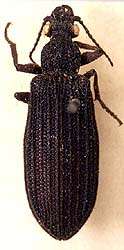Omma
Omma is a genus of beetles in the family Ommatidae. Omma is an example of a living fossil. The oldest species known, O. liassicum, lived during the final stage of the Triassic (Rhaetian), followed by several other species from Europe and Asia until after O. attenuatum from the Lower Cretaceous (lower Aptian), the genus then reappears in the Burmese amber during the Cenomanian, then disappears from the fossil record for the remaining 100 million years until today, with one species (Omma stanleyi) endemic to Australia, three other extant species that were formerly part of this genus were moved to the separate genus Beutelius in 2020.[1] The extant Omma stanleyi is strongly associated with wood, being found under Eucalyptus bark and exhibiting thanatosis when disturbed. Its larval stage and many other life details are unknown due to its rarity. Males are typically 14-20 mm in length, while females are 14.4-27.5 mm. Omma stanleyi occurs throughout eastern Australia from Victoria to Central Queensland.
| Omma | |
|---|---|
 | |
| Omma stanleyi | |
| Scientific classification | |
| Kingdom: | |
| Phylum: | |
| Class: | |
| Order: | |
| Suborder: | |
| Family: | |
| Genus: | Omma Newman, 1839 |
Species, temporal and spatial distribution
The following extinct and extant species have been described.[2][3]
- Omma aberratum Ponomarenko, 1968, Late Jurassic (Oxfordian and Kimmeridgian) Karabastau Formation, Karatau, Kazakhstan
- Omma altajense Ponomarenko, 1997, Middle to Later Jurassic, Togo-Khuduk sequence, Bakhar, Mongolia
- Omma antennatum Ponomarenko, 1997, Lower Cretaceous, Khurilt sequence, Bon-Tsagan, Mongolia
- Omma avus Ponomarenko, 1969, Lower Jurassic (Hettangian), Dgil’skaya Formation, Issyk-Kul’, Kyrgyzstan
- Omma brevipes Deichmueller, 1886, Upper Jurassic (Tithonian), Solnhofen Formation, Solnhofen, Germany
- Omma delicata Tan, Wang, Ren & Yang, 2012, Middle Jurassic (Bathonian-Callovian boundary), Jiulongshan Formation, Daohugou Village, Shantou Township, Ningcheng County, Inner Mongolia, China
- Omma gobiense Ponomarenko, 1997, Lower Cretaceous (Campanian), Ulan-Ereg Formation, Khoutiin-Khotgor, Mongolia
- Omma jurassicum Ponomarenko, 1968, Late Jurassic (Oxfordian and Kimmeridgian) Karabastau Formation, Karatau, Kazakhstan
- Omma liassicum Crowson, 1962, Late Triassic (Rhaetian), Lilstock Formation, Brown's wood, Warwickshire, England
- Omma mastersi MacLeay, 1871, recent, Australia. Moved to Beutelius
- Omma pilosum (Ponomarenko, 1964) = Ommamima pilosum, Late Jurassic (Oxfordian and Kimmeridgian) Karabastau Formation, Karatau, Kazakhstan
- Omma rutherfordi Lawrence, 1999, recent, Australia. Moved to Beutelius
- Omma sagitta Neboiss, 1989, recent, Australia. Moved to Beutelius
- Omma sibiricum Ponomarenko, 1966, Lower Cretaceous (Valanginian), Zaza Formation, Baissa, West Transbaikalia Russia
- Omma stanleyi Newman, 1839 (type), recent, Australia
- Omma zitteli (Oppenheim, 1888) = Procarabus zitteli, Upper Jurassic (Tithonian), Solnhofen Formation, Solnhofen, Germany
References
- Escalona, Hermes E.; Lawrence, John F.; Ślipiński, Adam (2020-01-24). "The extant species of the genus Omma Newman and description of Beutelius gen. nov. (Coleoptera: Archostemata: Ommatidae: Ommatinae)". Zootaxa. 4728 (4): 547–574. doi:10.11646/zootaxa.4728.4.11. ISSN 1175-5334.
- Ommatidae Species List Archived 2012-10-23 at the Wayback Machine at Joel Hallan’s Biology Catalog. Texas A&M University. Retrieved on 11 May 2012.
- Tan, Jingjing; Wang, Yongjie; Ren, Dong; Yang, Xingke (2012). "New fossil species of ommatids (Coleoptera: Archostemata) from the Middle Mesozoic of China illuminating the phylogeny of Ommatidae". BMC Evolutionary Biology. 12: 113. doi:10.1186/1471-2148-12-113. PMC 3518168. PMID 22776212.